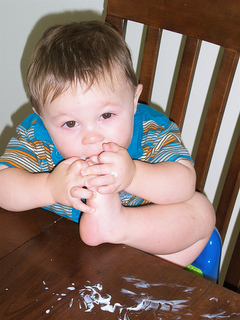Teaching Table Manners - Tips To Make It Easy
Teaching table manners is becoming more and more important in my opinion. I think that general etiquette and manners is eroding from our society. Therefore, I think we need to take a step back and review these principles that help us teach etiquette and manners to our children.
 Sure.
My kids are...well...kids. They are learning manners and etiquette as
we speak. They have bad habits that need correction, but we are working
on it. I watch their friends eat when they come over or I see them at
schools, and I notice the need for teaching table manners.
Sure.
My kids are...well...kids. They are learning manners and etiquette as
we speak. They have bad habits that need correction, but we are working
on it. I watch their friends eat when they come over or I see them at
schools, and I notice the need for teaching table manners.
At their age, manners are far from being important. However, it is easier to create good habits and correct bad habits at a young age than it is to do it when they are older. You can actually use these formative years of their life to your advantage.
The thing to keep in mind is that one day, our children will be the leaders of society. That means, we must use the time we have now to prepare them for their future. Believe it or not, a lack of etiquette will actually rob them of opportunities they could have had if they were not offensive to others.
Teaching Table Manners Tips
1. You must be consistent - If you are going to be successful at teaching manners to your children, you have to realize that it is not going to happen in a day. It will be a constant effort to instill these good habits on your children. If you cannot be consistent in teaching manners, then your children will not gain the desired results.
2. Be the example - One of the easiest ways for children to learn is to see an example and emulate the same behavior. You cannot teach them manners using the "do as I say and not as I do" method. When children have a proper role model to follow, they will mimic what they see being done and proper manners and etiquette will be the result. Family manners are a good way to set the example together.
3. Select one rule at a time - One of the hardest transitions for a child is to be taught too many things at once. If you trying to teach them a list of manners all at once, you are certain to get them frustrated and ultimately you will fail.
When you are teaching table etiquette, find the one rule that bothers you the most and focus on that. Work on it for a few weeks until they display the desired etiquette, and then add on the next rule. Keep doing this until all the proper table manners have been taught and demonstrated with your children.
4. Positive reinforcement will always produce better results than punishment - When it comes to child psychology, there are two different methods for teaching behaviors to children. One is that when they do something wrong, punish wrong behavior. The other is to reward when they have done something right. I have always preferred to reward positive behavior.
Simple rewards have always worked the best for our children. We have created charts on the wall. When they have done the desired behavior, we add a sticker to their chart. When they reach a pre-determined amount of stickers, we buy them a milk-shake or something else that they like.
The chart serves as a visual reminder of what we are working on and the reward teaches them what happens when they do the right thing. Although this is very simple, it has worked well for our children.
I hope these tips will make teaching table manners easier to do. You just have to make it a habit and be consistent in the way you teach.





